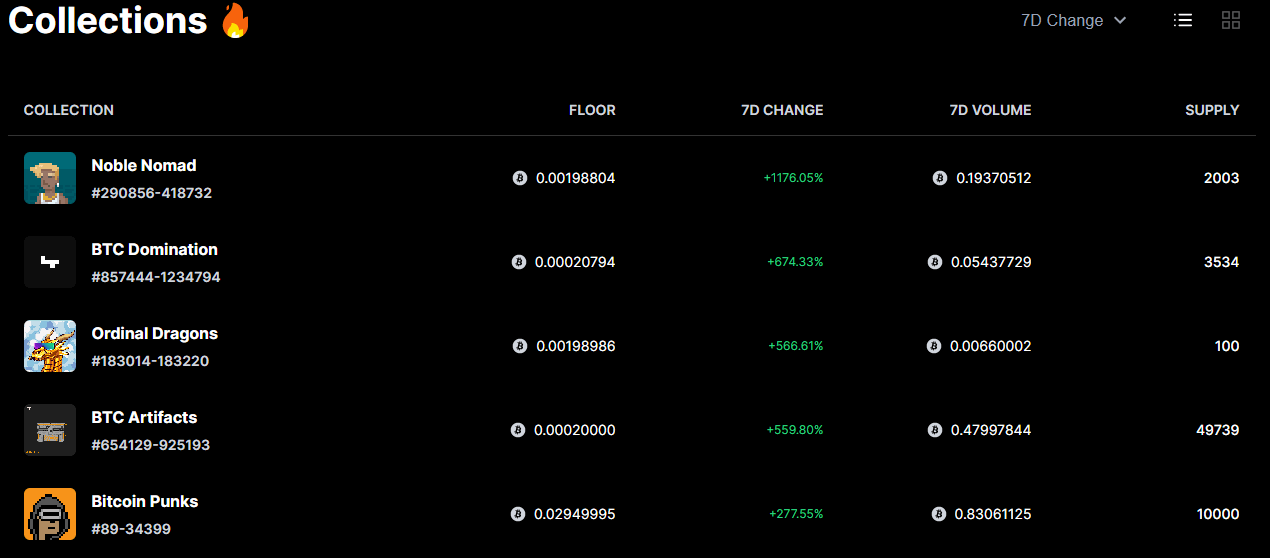フィアット通貨
仮想通貨
"" の結果はありません
検索に一致するものが見つかりませんでした。別の用語でもう一度お試しください。
What are Ordinals in NFT? Bitcoin NFTs Explained
Ordinal NFTs are a new way of creating non-fungible tokens (NFTs) on Bitcoin that was launched by developer Casey Rodarmor on January 20, 2023. Unlike other Bitcoin NFTs that rely on layer-2 networks such as Counterparty and Stacks, ordinal NFTs have a different design that allows them to be minted directly on the Bitcoin mainnet.
Since their launch, ordinal NFTs have attracted a lot of attention from users, developers, and enthusiasts who are interested in the potential of native Bitcoin NFTs. Over 200K ordinal NFTs have been created so far, and the number is growing every day.
What Are Bitcoin Ordinals?

Image: Ordinals.Market
Ordinals are a new protocol that allows users to number and track each satoshi across transactions. A satoshi is the smallest unit of bitcoin (BTC), equal to 0.00000001 BTC. By numbering satoshis, users can inscribe extra data on them, such as text or images, and make them unique. This process is called "inscription". Ordinals were launched by developer Casey Rodarmor on January 20, 2023, and use the Taproot upgrade to store data on the Bitcoin mainnet. Ordinals enable users to create digital assets similar to NFTs on Bitcoin.
The order in which satoshis are mined and transferred determines their numbering. The mining order is the basis for the numbering scheme, while the transaction inputs and outputs are the basis for the transfer scheme. This is why they are called "ordinals".
Ordinals and traditional NFTs have some similarities, but also some important differences. Traditional NFTs are usually created with smart contracts on blockchains like Ethereum, Solana, or the BNB Smart Chain, and sometimes the assets they represent are not stored on the blockchain. On the other hand, ordinals are written directly on individual satoshis that are part of the Bitcoin blockchain. Ordinals do not need a sidechain or a separate token. They are fully on the blockchain and share the same properties as Bitcoin: simplicity, immutability, security, and durability.
How are Bitcoin Ordinals different from Normal NFTs?
Some NFTs on Ethereum (or a similar blockchain) use off-chain data from the Interplanetary File System (IPFS) — a decentralized file storage system that works like the blockchain's hard drive — that can be modified with dynamic metadata. For example, some NFT projects change the metadata of individual NFTs to enhance image quality. They might even ask their holders to press the "refresh metadata" button on OpenSea to see the new, better-quality image.
Rodarmor created the new protocol to address a flaw he saw in NFTs: their reliance on off-chain data. He thinks NFTs are "incomplete" because many of them need off-chain data. But Ordinals are "complete" because all the data is written directly on-chain. That's why he calls them digital artifacts, not Bitcoin NFTs. Also, NFTs often have royalties for the creators, but digital artifacts do not. Rodarmor says an Ordinal "shows what NFTs should be, sometimes are, and what inscriptions always are, by their very nature."
This means that Ordinals on Bitcoin could be more than a cultural shift for Bitcoin—they could also be a technical upgrade on NFTs. With that in mind, here's how to get, receive, and store your first ordinals.
Closing Thoughts
The emergence of ordinal NFTs on the Bitcoin blockchain has triggered debates among Bitcoin enthusiasts about the core purpose and philosophy of Bitcoin.
Some contend that Bitcoin should be reserved for secure financial transactions, and that ordinal inscriptions, driven by memes, are wasting Bitcoin's blockspace and increasing transaction fees. Others are thrilled by the memetic/cultural value that ordinal NFTs can add to the Bitcoin blockchain and the possibility of Bitcoin extending its immutable, decentralized database beyond financial transactions.
Since ordinals are fully compatible with the current Bitcoin software, disabling the creation of ordinal inscriptions would necessitate a change to the Bitcoin protocol. Therefore, the Bitcoin community must collectively determine whether or not ordinals are here to stay.
で私たちをみつけて:
X (Twitter) | Telegram | Reddit
今すぐCoinCarpアプリをダウンロード: https://www.coincarp.com/app/
Up to $6,045 Bonuses
Sponsored
Join Bybit and receive up to $6,045 in Bonuses! Register Now!